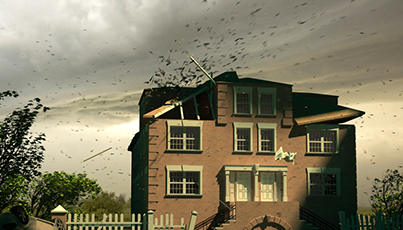In the following guest blog post from Acadia Insurance, one of the insurance companies we proudly represent, learn about the devastating damage that windstorms can cause to your property, along with wind preparedness tips that will help protect your business against these types of natural disasters.
A good house has a lot of nails in it.
I remember that statement from Gilly Harlow, my Homes and Buildings professor at Union College, more years ago than I care to admit. He was an older gentleman who wore a bowtie, had years of experience, and made many statements which stuck with me. And, “A good house has a lot of nails in it” is particularly true when we consider the peril of wind.
I have been reviewing industry loss data, trying to identify commonalities which can lead to better preventive measures. When we think of devastating property loss, we most likely think of fire, which is true, but is fodder for another blog. What may come as a surprise is that wind damage rivals the figures of fire losses.
Consider the following scenarios:
 A tractor trailer is out in high winds and suffers a gust perpendicular to its trailer. The entire unit turns over, damaging the cab, trailer, and contents, leaving an unhappy customer with damaged and undelivered cargo.
A tractor trailer is out in high winds and suffers a gust perpendicular to its trailer. The entire unit turns over, damaging the cab, trailer, and contents, leaving an unhappy customer with damaged and undelivered cargo.- A low pitched roof overhangs the edge of a building, and the business owner has been meaning to repair some flashing damage. This compromised flashing is no match for a strong gust, and the wind gains momentum, essentially turning the roofing material into a sail, lifting it off. This results in damage to the roof, while leaving the occupants and contents vulnerable to the elements.
- A large tree limb falls, as luck would have it, directly onto the incoming power supply to a business. The company happens to be a cold storage warehouse, and now must race against time to preserve any stored products.
To help your business weather storms like those above, consider the following actions:
Survey your property to assess vulnerabilities in fairer times and make any adjustments or repairs that you can. A building in well maintained condition stands up to the elements much better than one which has a longer “to do” list associated with it. Tips to consider include:
- Roof, flashing, drainage and eaves elements that are in poor condition or not well secured, may give wind a foothold toward damage.
- Damaged or poorly attached siding, which can be ripped off by the wind.
- Exposed utility and communication lines which can become severed and multiply potential problems!
- Poorly secured exterior elements, such as planters, furniture, etc.
- Low hanging or dead limbs which can break off and become wind missiles.
- Signage which may be poorly attached or otherwise loose.
- If in doubt, enlist the services of a professional contractor for an assessment and advice.
Create a formal plan to batten down the hatches for the inevitable storm. Ideas may include:
- Assign a person who is accountable for enacting a plan for premises securement upon news of an impending storm.
- Secure or remove exterior items which may be vulnerable to high winds.
- Have a plan in place to communicate the emergency to employees.
- Have a backup plan for power and communication services commensurate with your business’s needs.
- Regularly inspect your property to identify wind vulnerabilities and overall conditions.
It has also been said in many venues, from property insurers to experts from the Federal Emergency Management Administration, that one of the most cost-effective things a home or business owner can do to help minimize wind damage is to invest in additional fasteners on flashing and leading edges. These areas are subject to the most extreme wind forces. So, there may be wisdom in Professor Harlow’s words. Although roofing materials are secured with hardware a bit more complex than nails, the spirit of the statement is likely true – a good building does have a lot of nails.
I challenge you to review your company’s susceptibilities to weather-related disaster, including high winds, and take action to protect your assets.
For additional information, you can contact your Acadia Loss Control Representative or utilize the following: http://www.fema.gov/
And remember: don’t forget to subscribe to our blog! Stay informed on risk management information, tips and advice from Acadia Insurance specialists that are relevant to your business!
